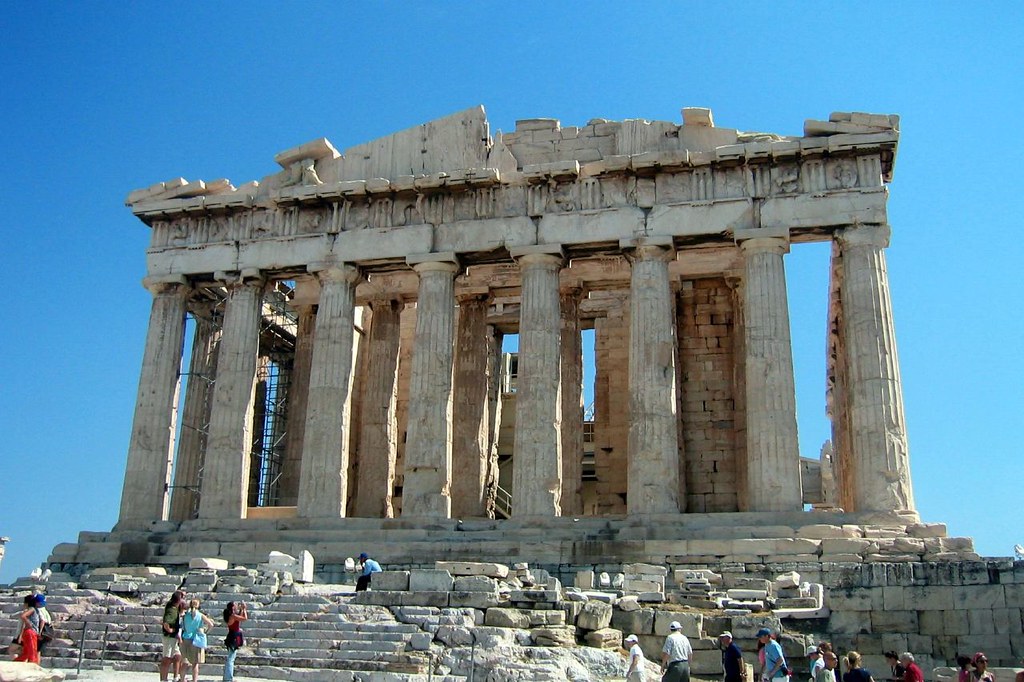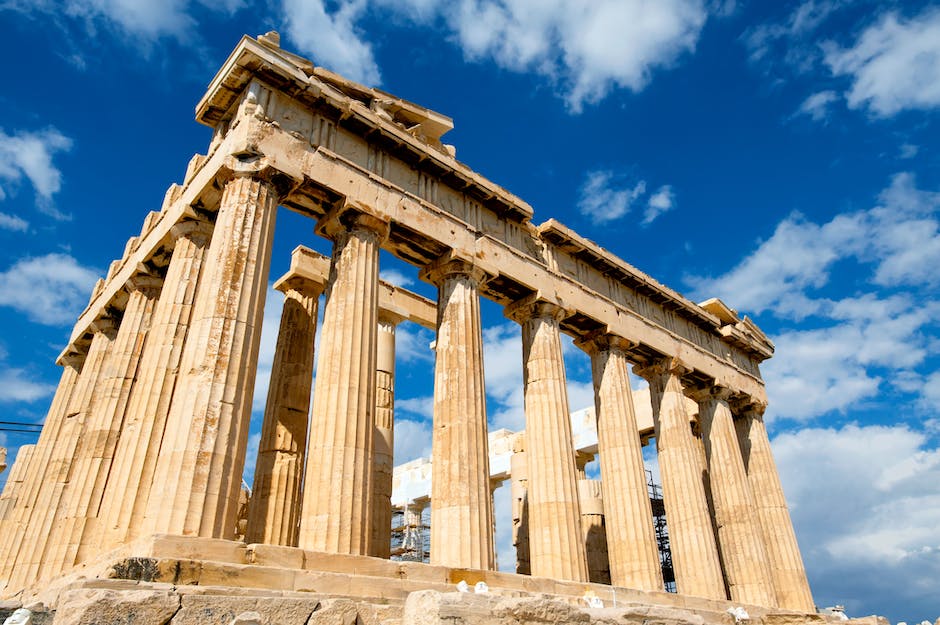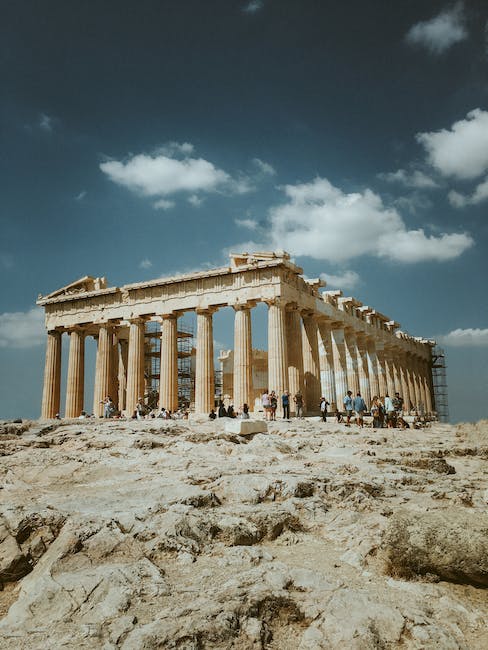In the realm of architectural wonders, few structures stand as tall and resolute as the Parthenon, an unrivaled testament to the boundless creativity and genius of ancient Greece. With its majestic columns reaching skyward, the Parthenon stands as an enduring symbol of classical Greek architecture, encapsulating the grandeur and artistry of an era long past. Surrounded by a veil of mystery and awe, this iconic masterpiece has captivated generations with its ethereal beauty and meticulous design. Join us as we embark on a journey through time, exploring the magnificence of the Parthenon and uncovering the secrets behind its enduring legacy that continues to inspire and amaze to this day.
– The Parthenon: Masterful Blend of Beauty and Precision
The Parthenon, standing proudly atop the Acropolis hill in Athens, Greece, is undoubtedly the quintessential icon of classical Greek architecture. This masterpiece of engineering and design, constructed in the 5th century BC, embodies the pinnacle of ancient Greek artistry and remains an enduring symbol of beauty and precision.
What makes the Parthenon truly remarkable is its harmonious blend of aesthetic excellence and meticulous craftsmanship. The temple’s imposing Doric columns, brought to life with unparalleled precision, create an awe-inspiring sight that stirs the soul. Each column, carefully carved from marble, stands tall and proud, adorned with intricate decorations that celebrate the rich mythology and historical significance of ancient Greece. The precise alignment of every column, calculated to visually correct any optical illusion, demonstrates the meticulous attention to detail that the architects possessed.
The Parthenon’s exterior facade, decorated with intricate friezes and metopes, is a testament to the Greeks’ commitment to perfection. These masterfully sculpted reliefs depict scenes from Greek mythology, showcasing their cultural and artistic achievements. The architects ingeniously employed the principles of perspective, ensuring that these artistic marvels appeared proportionate and balanced to the human eye.
Inside the Parthenon, visitors are greeted by the awe-inspiring sight of the monumental statue of Athena Parthenos, the goddess of wisdom and warfare. This colossal ivory-and-gold sculpture, created by the renowned sculptor Phidias, radiates grandeur and divine power. The careful arrangement of architectural elements, such as the calculated slope of the floor and the intricate play of light and shadow, further enhances the overall aesthetic appeal of the interior space.
– Architectural Marvel: Unraveling the Secrets of the Parthenon’s Construction
The Parthenon, an architectural masterpiece, stands as a timeless homage to classical Greek architecture. Its majestic presence atop the Acropolis in Athens captivates visitors from around the world. Built in the 5th century BCE, this iconic structure showcases the immense skill and engineering prowess of the ancient Greeks.
The secrets behind the Parthenon’s construction continue to intrigue modern scholars and archaeologists, as they unravel the intricate details of its design and engineering. Here are a few fascinating facts that shed light on the architectural marvel:
- Meticulous Construction: The Parthenon was built using the Doric order, a style known for its sturdy and harmonious proportions. Each column was carefully crafted to stand straight and tall, creating an aura of strength and grace.
- Optical Illusions: The architects of the Parthenon incorporated optical refinements, such as slight curvature and tapering, to counteract visual distortions caused by the eye. These subtle adjustments create an illusion of perfection, enhancing the overall aesthetic appeal of the structure.
- Marble Marvel: Constructed primarily from Pentelic marble, the Parthenon’s facade once gleamed in pure white brilliance. Its splendid appearance would have had a profound impact on ancient visitors.
- Intricate Sculptures: Elaborate friezes adorned the exterior of the Parthenon, depicting legendary mythological scenes and celebrating the achievements of Athens. These intricate sculptures showcased the artistic prowess of the ancient Greeks and added a touch of timeless beauty to the structure.
The Parthenon continues to inspire awe and admiration, symbolizing the unparalleled architectural achievements of the ancient world. Exploring its construction secrets reveals not only the technical brilliance of the ancient Greeks but also their profound dedication to art and culture.

– A Must-See: Exploring the Timeless Allure of the Parthenon
Step into the ancient world of classical Greece and marvel at the eternal beauty of the Parthenon, an architectural masterpiece standing proudly atop the Acropolis in Athens. With its iconic marble columns and intricate friezes, this temple dedicated to the goddess Athena is a true testament to the skill and ingenuity of ancient Greek craftsmen. Whether you are a history enthusiast or simply appreciate the magnificence of architectural wonders, a visit to the Parthenon is an absolute must.
As you approach the grand entrance, the immensity of the Parthenon immediately commands your attention. Standing tall against the azure sky, the temple’s perfect symmetry and carefully designed proportions are awe-inspiring. The Doric columns, adorned with intricate fluting, effortlessly draw your eye upwards towards the imposing pediment that once showcased statues depicting the epic battles of Greek mythology. Exploring the ruins, you’ll discover the beauty lies in the details – the delicate carvings depicting scenes from ancient Greek life, the intricately painted metopes that depict the heroic exploits of gods and heroes, and the majestic statue of Athena Parthenos that once stood within the temple.

– Preserving the Parthenon: Strategies for Safeguarding an Ancient Wonder
The Parthenon, an enduring symbol of Classical Greek architecture, stands as an extraordinary testament to human ingenuity and artistic prowess. However, the passing centuries have taken their toll on this iconic structure, requiring diligent efforts to preserve its historical significance and architectural integrity. To ensure that future generations can continue to marvel at this ancient wonder, a comprehensive strategy for safeguarding the Parthenon is of utmost importance.
1. Conservation and Restoration:
- Implement careful cleaning techniques to remove accumulated dirt and pollutants, enhancing the visibility of the Parthenon’s intricate marble details.
- Repair weathered and eroded surfaces using scientifically advanced restoration methods, employing compatible materials to mimic the original aesthetics.
- Stabilize the structural elements of the Parthenon, reinforcing weakened areas and addressing any hazards that may threaten its stability.
2. Advanced Monitoring and Maintenance:
- Utilize cutting-edge technology like high-resolution 3D scanning to assess the Parthenon’s condition, aiding in the early detection of potential risks.
- Implement a regular inspection schedule to monitor the structure’s vulnerability to environmental factors such as rain, temperature changes, and seismic activity.
- Establish a conservation team comprised of experts in historical preservation, architecture, and structural engineering, ensuring a proactive approach to maintenance and swift response to emergencies.
By embracing a comprehensive strategy that combines conservation, restoration, monitoring, and maintenance, we can safeguard the Parthenon for generations to come. Life may have weathered its ancient stones, but with our unwavering dedication and cutting-edge techniques, this awe-inspiring testament to ancient Greece’s architectural splendor will continue to inspire and captivate the world.
To Wrap It Up
As the sun begins to set over the ancient city of Athens, we bid farewell to the majestic icon that has captivated the hearts and minds of millions. The Parthenon, a masterpiece of classical Greek architecture, stands tall and proud, a testament to the ingenuity and brilliance of its creators.
With its harmonious proportions and flawless design, the Parthenon embodies the essence of an era that continues to inspire awe in the hearts of historians, architects, and dreamers alike. Its graceful columns, adorned with intricate carvings, seem to whisper tales of gods and goddesses, battles fought and victories won, as if speaking directly to our souls.
The Parthenon’s importance cannot be overstated; it transcends the boundaries of time and space to connect us to the profound wisdom and artistic vision of our ancient ancestors. It serves as a reminder that beauty, wisdom, and knowledge are everlasting, and that they are the building blocks upon which civilizations are shaped.
As we stroll through the ruins, tracing the footsteps of those who walked before us, we cannot help but marvel at the scale and complexity of this architectural marvel. The immaculate symmetry, the intricate marble friezes, and the delicate interplay of light and shadow beckon us to contemplate the mysteries of life itself.
Standing amidst the ruins, one can’t help but feel a sense of reverence and wonder for the countless generations that have come and gone, leaving their mark on this sacred site. The Parthenon, a silent witness to the ebb and flow of time, remains steadfast, a monument to the eternal quest for truth and beauty.
As we bid adieu to this unforgettable journey, let us carry a piece of the Parthenon within our hearts. Let the lessons it teaches us resonate through the ages, reminding us to strive for greatness, to honor our cultural heritage, and to stand tall in the face of adversity.
And so, as the sun finally dips below the horizon, we take a final glance back at the Parthenon, awestruck by its enduring allure. Though time may weather its stones, the spirit it embodies will forever remain, casting a timeless glow upon the annals of history.
For the Parthenon, dear reader, is not merely a relic; it is a living testament to the resilience of the human spirit and a beacon of inspiration for generations to come.

